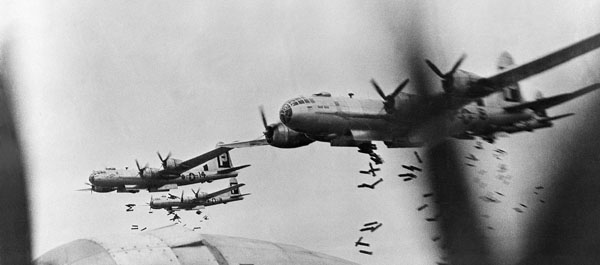
Whirlwind: The Air War Against Japan 1942–1945
By Barrett Tillman. 336 pp. Simon & Schuster, 2010. $28.
In 1944 and 1945, Japan faced the most relentless air assault in history. Formations of the world’s most technologically advanced bomber, the B-29 Superfortress, firebombed its cities one by one. Swarms of United States Navy carrier aircraft pummeled its harbors and coastal regions. A sustained aerial mine-laying campaign choked off what remained of its maritime commerce after the navy’s aggressive submarine campaign had taken its toll, and long-range fighters from Iwo Jima roved across its territory. While several worthy books have covered aspects of this air effort, none offers the comprehensive inter-service and international perspective of this concise account by a prolific naval and air power historian.
Whirlwind, though deceptively short, offers an impressive 360-degree look at the air offensive against Japan’s home islands. All of the story’s major elements are here, as well as some frequently omitted—the contributions of the British Pacific Fleet carriers in the last months of the war, the long-distance U.S. raids against the Kuril Islands from fog-bound bases in the Aleutians, and the efforts of the air-sea rescue organizations. There are many small narrative gems, such as an account of how members of a P-51 unit based on Iwo Jima amended their lack of amenities by building a sauna. These are drawn from a mixture of official histories, new scholarship, and many firsthand accounts from veterans.
The material on the Japanese defenses is noteworthy. Tillman provides a detailed portrait of the Japanese military and civilian leadership’s catastrophic inability to defend home airspace and protect the population. Using infrequently cited postwar studies, intelligence reports, and interviews, he documents how Japanese aviators struggled to combat the B-29 and naval air assaults. Though their successes were rare, Tillman has uncovered a few cases where individual Japanese pilots and units managed to land punches. That said, he assesses Japanese air defense as a comprehensive failure with many fathers. The account of the lack of Japanese firefighting capability is especially poignant. Even the largest cities possessed few modern fire engines; most boasted the capacity of a medium-sized American municipal fire department circa 1890.
Whirlwind is much more than a simple narrative history. Tillman weighs in on most of the major controversies surrounding the bombing of Japan. His analyses of Japanese and Allied strategy and operational decision-making are concise and on the whole persuasive. He tends to dismiss many of the postwar moral criticisms of Allied actions, such as Curtis LeMay’s firebombing and the use of atomic bombs, and he argues that LeMay was perhaps the most effective air commander of any age. Yet Tillman is no whitewasher; the inter-service battles that caused needless casualties and wasted effort come in for harsh criticism. All things considered, his brief, punchy account is a welcome addition to the growing literature of the air war in the Pacific.




